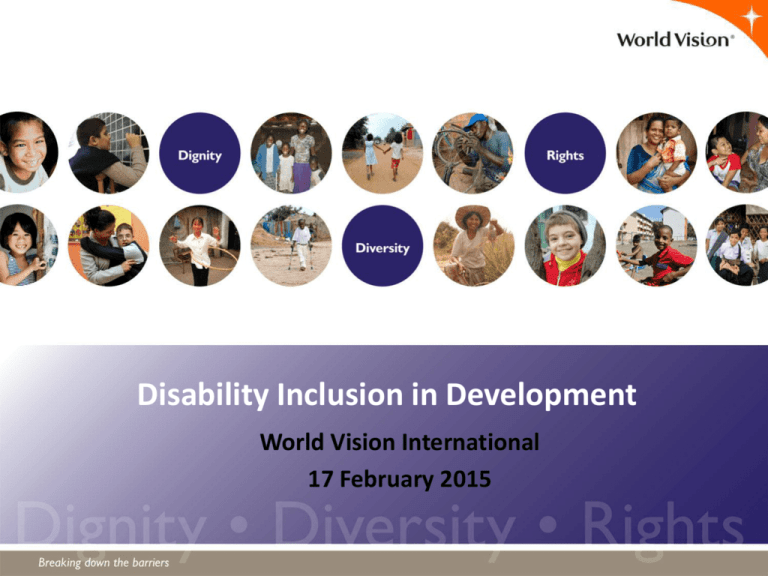
Disability Inclusion in Development
World Vision International
17 February 2015
Agenda
• Understanding Disability
• Approach to inclusion
• Challenges
• Opportunities
• Promising practices
What is disability?
Conventional understanding
• Visual
• Hearing / speech
• Movement (or polio, landmine victims)
• Intellectual (or Down’s syndrome, meningitis)
• Mental illness (psycho-social)
• Others (e.g., epilepsy, leprosy)
• Autism
What is disability?
Holistic understanding
– Impairments (medical / individual issue)
– Function / functional limitations
– Barriers to participation (social issue)
Attitudinal, Environmental, Institutional
Disability: A ‘result of the limitations imposed’ on people
With impairments by attitudinal, institutional, and
environmental barriers to their participation in society.
Not about inability, illness or permanent injury.
Social issues and impairments.
Participation based on rights, NOT ability, capacity or needs.
CRC guarantees rights of every child.
Attitudinal barriers
Often invisible, most problematic and deeply rooted
Stigma
Curse, bad luck
Not normal
Not worthy Lazy; Helpless
Unintelligent
Lack of skills Incapable
Crazy
Tragic
Sick
In need of care
Weak
Non-sexual…..
Assumptions
…can lead to: Discrimination (e.g., little social support, birth
registration); social exclusion (e.g., family, friends, school,
community); violence including infanticide; lack of self-esteem and
social skills; etc.
Systemic / Legal barriers
Religion, education, health and other social services and systems;
Employment, political systems
Humanitarian and development programmes / assistance
Less likely to have access to info about their rights or to social
protection and justice systems
What are some barriers / discrimination you are aware in your
country or your programme?
Environmental barriers
Infrastructure:
Public transport
Roads
Housing
School
WASH points
Health clinic
Bank
Office
Church, mosque, temple
Leisure and recreation places
Library
Community hall
Markets, shopping places
Info and communications:
How we communicate (F2F conversations,
phone/skype, email, webex)
Social services
Communication systems including posters, newspaper, radio or TV
Global Situation
15% of population (1 billion) have disabilities, over 80% in low-income countries.
95-150 million children with disabilities globally.
Direct link between poverty, discrimination and disability.
82% live below poverty line. 20% of the world’s poorest have disability, and
regarded as most disadvantaged in their community.
90% cwd receive no education or 1/3 children not in school a cwd. ( global
literacy rate as low as 3%, for women 1%)
3-5 times more likely to be victim of violence and physical or sexual abuse than
non-cwd. Children with intellectual disabilities: 4-10 times higher risk of sexual
abuse.
30% of children/youths living on the street has disabilities
Girls with disabilities and those with indigenous or
minority ethnic backgrounds are at more risk and
disadvantage b/c of double, triple discrimination.
An approach towards Disability inclusion
Inclusion and equitable access in programs
Special support for those at risk / most vulnerable
•
•
•
•
•
•
•
•
Full and meaningful
participation in
programs
Disability awareness for staff and community
o With DPO, FBO
Assessment : Learn about situations in the community
Representation (Community, women, children, different types of disability)
Participation of Community-based DPO in DME / programming
o Barrier analysis
o Data disaggregation
o Measuring progress and outcomes
Impact: Inclusion in
community
Standardization, e.g., facilities’ design
Support for establishment and capacity building of DPO
Collaboration with specialist organisations
Advocacy at community, nat’l and int’l levels by children and youths with disabilities
WASH
Inclusion practice
- Standardization of accessible WASH at school and home/community
- Impact on other areas of life – education, protection, health, self-esteem,
social skills, economic activities
Main challenges:
-
Low awareness of impact of inaccessible WASH
Government approved design
Perception and actual costs of accessible WASH
Low priority of WASH for community people
Opportunities:
-
Partnership with expert organisations
Participation of community people with disabilities (real experts!)
For everybody, not only for people with disabilities
Once the importance is understood, people with disabilities take ownership
Education
-
Inclusion practice
Inclusive education vs Special education
Inclusion in ECD
Children’s clubs, Buddy support
Community assessment
Training of teachers – pre and primary school
Main challenges:
-
Negative attitude and low expectations
Inaccessible school infrastructure including WASH
Readiness of school, DOE
Transportation
Opportunities:
- Expertise of local universities, MOE,
- Inclusion in ECD provides life long impact
Savings Group
Inclusion practice
- Three main types:
(1) Inclusion in regular SG
(2) Separate SG within regular SG project
(3) Separate project for persons with disabilities
Main challenges:
- Negative attitude including low expectation
- Lack of capacity (e.g., literacy, computation skills),
self-confidence, accountability for some
- Weak family and social support structure
- Transportation, accessibility
Opportunities:
- Target parents with disabilities and of children with disabilities
- Success stories become role model for children and youths with disabilities
- Inclusion in SG creates sense of belongingness, dignity and choice/freedom
Key issues / lessons
• Disability sensitisation is a starting point
• Access issues – infrastructure, transportation, communications, social services
• Participation and representation, with gender sensitivity
• DPO non-existent or lack of capacity in rural and remote areas
• Main support needs expressed by community: Economic activities, e.g., SG,
VSLA, education
• Gaps in policies (strategies) and implementation.
• Data disaggregation
• Use of local resources (expertise, support from local business sectors)
• Support from local govt. and DPO strengthened when they participated in
community assessment.
• Each issue of the most vulnerable people / children is unique and diverse.
Thank You









